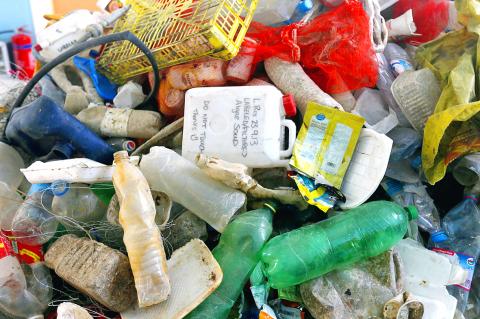For years along the Cornish coast of Britain, Atlantic Ocean currents have carried thousands of Lego pieces onto the beaches. In Kenya, cheap flip-flop sandals are churned relentlessly in the Indian Ocean surf, until finally being spit out onto the sand. In Bangladesh, fishermen are haunted by floating corpses that the Bay of Bengal sometimes puts in their path.
And now, perhaps, the oceans have revealed something else: parts of Malaysia Airlines Flight 370, the jetliner that vanished 17 months ago with 239 people on board.
Experts believe it crashed into the vast emptiness of the Indian Ocean, somewhere between Africa and Australia. While some wreckage presumably sank, some is also thought to have joined the millions of tons of oceanic debris — from Legos accidentally spilled from cargo ships to abandoned fishing nets to industrial trash — that can spend years being carried by the Earth’s currents, sometimes turning up thousands of miles away from where they entered the water.

Photo: Reuters/Vincent West
CHURNING OCEANM
So there was little surprise among oceanographers when part of a jet’s wing, suspected wreckage from the vanished Boeing 777, was found two weeks ago along the shores of Reunion, a French island off the African coast. Malaysian investigators were also dispatched this week to the Maldives, a South Asian archipelago nation, to examine debris that had recently washed ashore there.
“The ocean is not a bathtub. It’s in constant motion,” said Erik van Sebille, an oceanographer with the Grantham Institute at Imperial College London who has spent years studying how currents carry debris. “At the surface it’s this giant, churning machine that moves things from A to B,” he said. “And it’s connecting all the areas of the globe.”

Photo: Reuters/Muhammad Hamed
Often, that giant churning machine also moves in fairly predictable ways, with currents and winds moving in predictable directions and speeds.
Charitha Pattiaratchi, an oceanographer at the University of Western Australia, used computer modeling last year to predict that debris from Flight 370 might end up somewhere near Reunion, or nearby Madagascar, about now.
But he said that if the wing part found on Reunion turns out to be from Flight 370 — French investigators are still examining it, though Malaysian officials have said it definitively came from the disappeared jet — then he doubts the debris found in the Maldives is also from the jetliner.
Because the Maldives lie north of the equator and Reunion Island is to the south, finding wreckage in both spots is highly unlikely, he said, because ocean currents and winds make it extremely difficult for flotsam to cross the equator.
Plus, he adds, it would be exceedingly difficult for any Flight 370 debris to have ended up in the Maldives at all by now. To reach there, the wreckage would have had to float west from the current search area off Australia and toward Africa, then turn north and travel along the African coast past Somalia and into the Arabian Sea, before turning south and east toward the Maldives. That would be a massive journey to make in just 17 months; debris found on Reunion, in contrast, could have traveled in a relatively simple counterclockwise arc.
“If it is from MH370, then that’s a very hard thing to explain. Not entirely impossible, because we’re talking about nature,” he said.
THE DISAPPEARANCE OF FLIGHT 370
Flight 370 disappeared March 8, 2014, on its way from Kuala Lumpur to Beijing. While officials believe it crashed in the Indian Ocean, killing all aboard, the wreckage and cause remain elusive despite a vast ongoing search led by Australia.
Finding anything specific amid the oceanic junk piles requires immense effort.
Just how much debris is out there? No one knows, though certainly the scale is enormous.
According to a study this year, the world dumps 8.8 million tons of plastic into the world’s oceans every year. The study, led by University of Georgia environmental engineering professor Jenna Jambeck, warned that in a decade the plastic trash in the oceans could total 170 million tons.
CLUSTERS OF JUNK
Sometimes it clusters together. Scientists have identified five garbage patches, gargantuan corrals of debris formed by circular ocean currents. One, the so-called Great Pacific Garbage Patch, could be as large as Texas.
But do not, van Sebille warns, picture masses of garbage floating on the surface of the water. “These are not islands of trash. There are no big pieces that you can stand on, even in the garbage patches,” he said. Instead, those millions of tons of plastic quickly disappear from view, reduced to a near-invisible cloud that floats just beneath the surface.
“After a few months, the sea and sun have completely broken down the plastic into a confetti of tiny, tiny pieces,” he said. The small size, he notes, doesn’t make them environmentally friendly. The minuscule particles can be even more dangerous, he said, because they can easily enter the food chain after being eaten by small fish, and are extremely difficult to clean up.
In Kenya, Julie Church has found a use for some flotsam. The marine conservationist, inspired by village children who turn beach debris into toys, created a company that transforms castoff sandals into bright sculptures and playthings. Today, Ocean Sole recycles an average of 1,000kg of flip-flops each week. Judging by the trash they find around the sandals, Church thinks some footwear floated to Kenya from as far as Indonesia and Malaysia.
But that’s a rare happy ending amid so much debris. More often, it’s a litany of the prosaic and the strange.
There are the wealth of goods dumped into the water when hundreds — and sometimes thousands — of shipping containers are lost at sea every year. Those Legos on the Cornish coast come compliments of a container thrown overboard by a rogue wave in 1997.
There are the thousands of buoys that have littered beaches in Alaska, along with building insulation, property stakes and crates used by fishermen. There was the 164-foot ship cast adrift after Japan’s 2011 tsunami and sunk by the US Coast Guard in the Gulf of Alaska in 2012 before it could reach shore.
There are the corpses that Mohammed Nasir sees as he fishes in the Bay of Bengal.
“I have seen many such bodies in my life,” said the 53-year-old Bangladeshi. “I often think how unlucky they are. They have left their families behind.”
But mostly? Mostly it’s garbage. Thousands and thousands of tons of garbage.
Chris Pallister, president of Gulf of Alaska Keeper, a beach cleanup organization, said by email that nearly everything his crews find is trash.
Sometimes, though, even that has emotional impact.
“Such as shoes, particularly in my case, infant shoes,” he said. “When you contemplate where they come from, it can be quite disturbing.”
— Additional reporting by Becky Bohrer, Julhas Alam and Kristen Gelineau

On April 26, The Lancet published a letter from two doctors at Taichung-based China Medical University Hospital (CMUH) warning that “Taiwan’s Health Care System is on the Brink of Collapse.” The authors said that “Years of policy inaction and mismanagement of resources have led to the National Health Insurance system operating under unsustainable conditions.” The pushback was immediate. Errors in the paper were quickly identified and publicized, to discredit the authors (the hospital apologized). CNA reported that CMUH said the letter described Taiwan in 2021 as having 62 nurses per 10,000 people, when the correct number was 78 nurses per 10,000

As we live longer, our risk of cognitive impairment is increasing. How can we delay the onset of symptoms? Do we have to give up every indulgence or can small changes make a difference? We asked neurologists for tips on how to keep our brains healthy for life. TAKE CARE OF YOUR HEALTH “All of the sensible things that apply to bodily health apply to brain health,” says Suzanne O’Sullivan, a consultant in neurology at the National Hospital for Neurology and Neurosurgery in London, and the author of The Age of Diagnosis. “When you’re 20, you can get away with absolute

May 5 to May 11 What started out as friction between Taiwanese students at Taichung First High School and a Japanese head cook escalated dramatically over the first two weeks of May 1927. It began on April 30 when the cook’s wife knew that lotus starch used in that night’s dinner had rat feces in it, but failed to inform staff until the meal was already prepared. The students believed that her silence was intentional, and filed a complaint. The school’s Japanese administrators sided with the cook’s family, dismissing the students as troublemakers and clamping down on their freedoms — with

As Donald Trump’s executive order in March led to the shuttering of Voice of America (VOA) — the global broadcaster whose roots date back to the fight against Nazi propaganda — he quickly attracted support from figures not used to aligning themselves with any US administration. Trump had ordered the US Agency for Global Media, the federal agency that funds VOA and other groups promoting independent journalism overseas, to be “eliminated to the maximum extent consistent with applicable law.” The decision suddenly halted programming in 49 languages to more than 425 million people. In Moscow, Margarita Simonyan, the hardline editor-in-chief of the